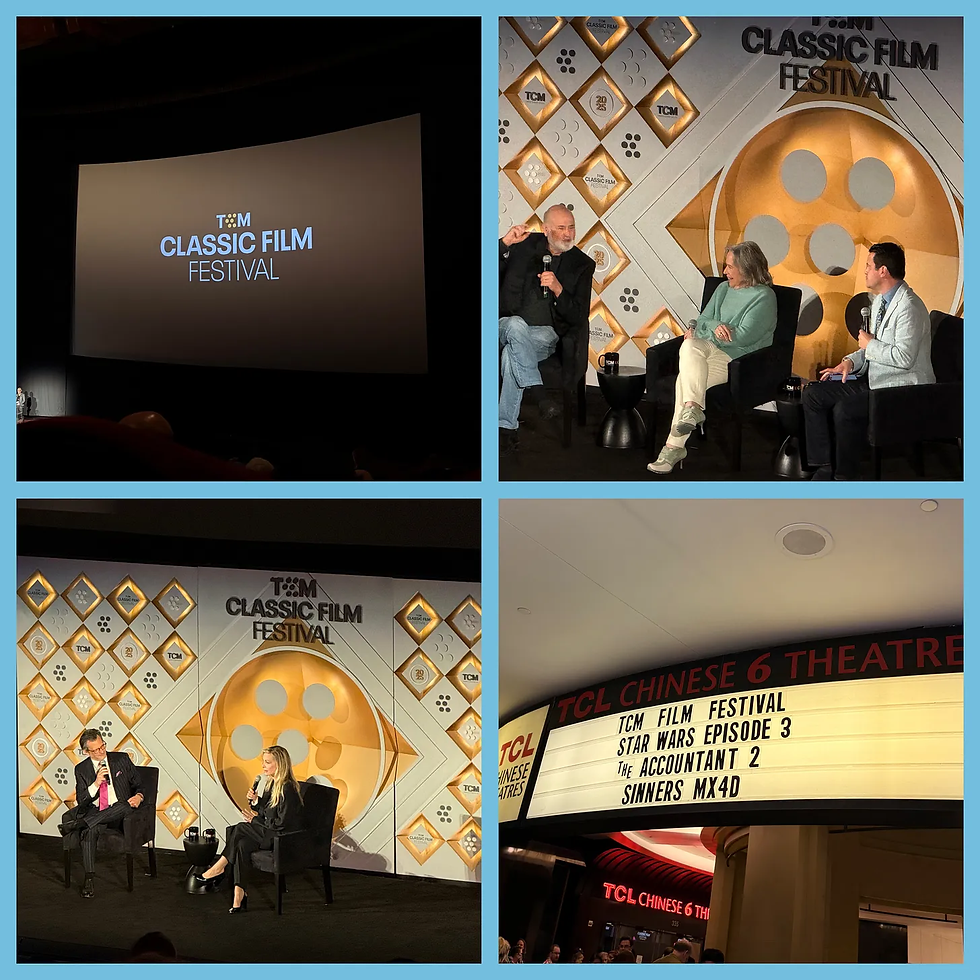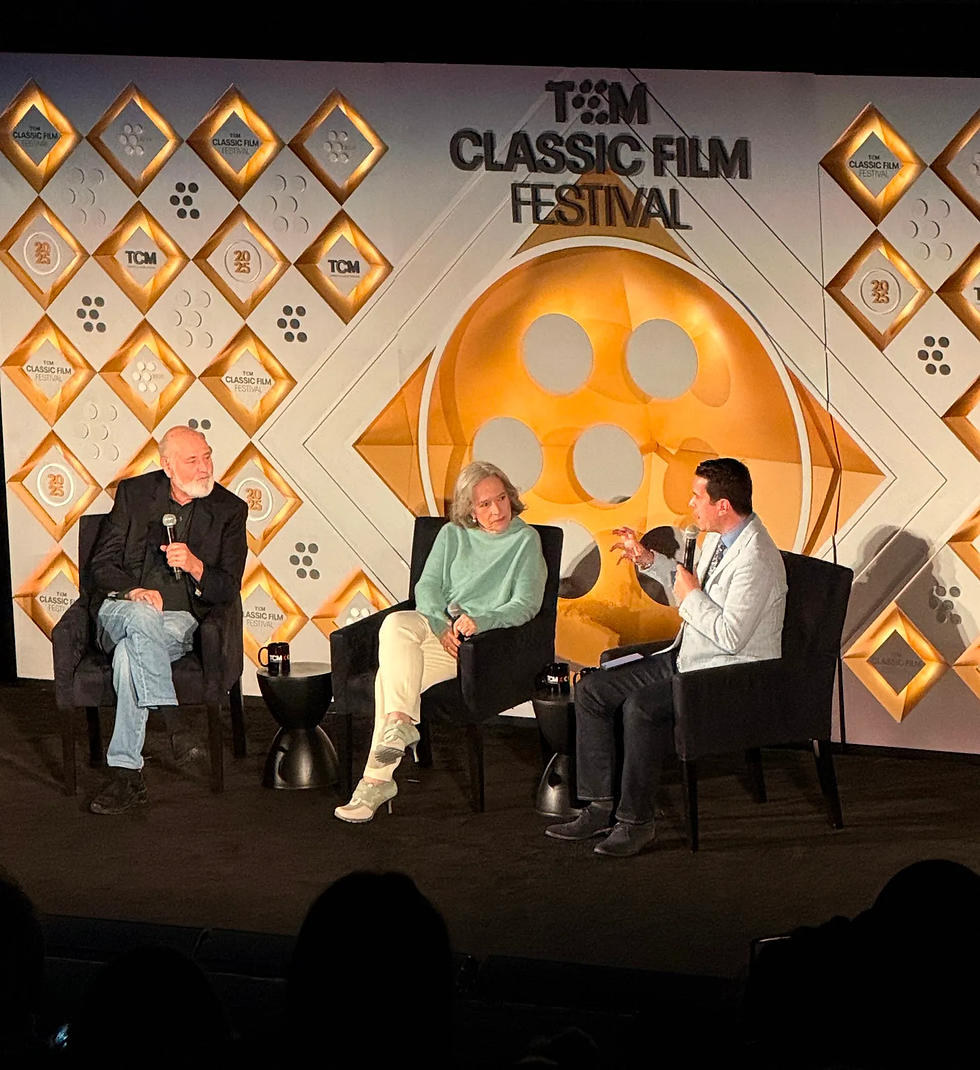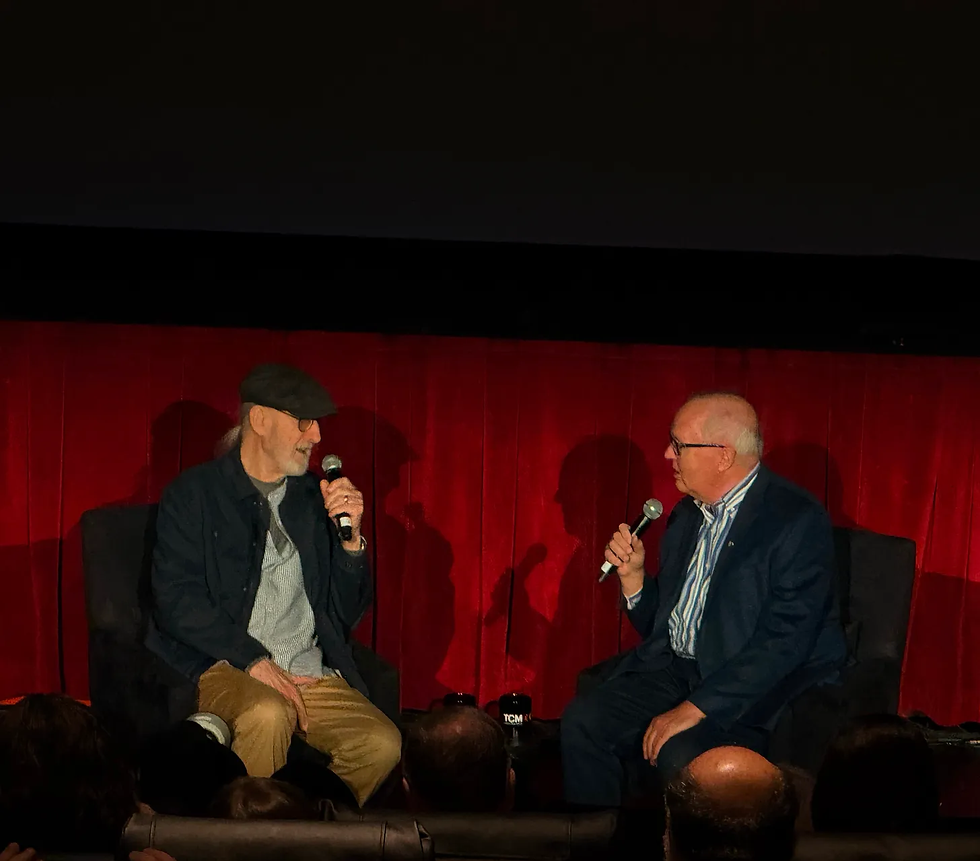A Movie-Packed Weekend at the TCM Film Festival
- Tina Ter-Akopyan
- May 5
- 9 min read
For any classic movie lover, the TCM Film Festival on Hollywood Blvd. is the equivalent of Coachella weekend. Packed with screenings of all-time classics as well as lesser-known discoveries (shown in every format from 35mm to DCP to even nitrate), the TCM Film Festival preserves film history and celebrates the movie-going experience. Over the festival’s 16 years, the enthusiasm of the attendees has only grown for the beloved network channel, which has introduced so many to classic cinema. As an attendee of the festival from 2017, I have made countless memories from taking a chance on movies I did not even know existed to rewatching some of my favorite films with a lively crowd applauding, gasping, and laughing all the way through. This year, I set a record, alongside my brother, and watched seven films over three days. Here is a rundown of all the wonderful films we watched at the Festival:

Thursday, April 24:
Suspicion (1941)
While I suspected many festivalgoers would attend the opening night screening of Star Wars: The Empire Strikes Back (1980) at the Chinese Theater, I was surprised to walk into a packed theater for Suspicion, one of Hitchcock’s lesser-known films. Straight off the success of his first and only Best Picture winner, Rebecca (1940), Hitchcock wanted to adapt another psychological thriller novel, this time Anthony Cox Berkeley’s novel Before the Fact, which focuses on distrust, fear, and murder – the hallmarks of any great Hitchcock film. Starring Oscar-winner Joan Fontaine, who is the only actress Hitchcock directed to an Oscar, as Linda, and the charismatic and flirtatious Cary Grant as the unreliable Johnny, the film’s plot centers around the loving yet heated tension between a husband and a wife, who suspects her partner of being a murderer for money. While Linda initially falls in love with Johnny’s personality, Johnny, with no stable job and a gambling addiction, falls in love with the prospect of her money.
Told entirely from the perspective of Linda, Hitchcock sprinkles foreboding clues to make the audience also suspect Johnny. For example, Hitchcock teases the audience as they watch Johnny’s eye light up when the topic of poison comes up during dinner. From constantly lying about his finances to going on mysterious trips, Johnny seems like the perfect culprit; however, through Grant’s lighthearted nature, the audience always second-guess Linda’s suspicions, never quite sure of what Johnny thinks.

Although the suspenseful climax, where the audience hopes to finally learn Johnny’s true intentions, ends abruptly, this film showcases the timeless and entertaining nature of Hitchcock’s films.
Friday, April 25:
Thunderball (1965)
Bright and early the next morning, we started the second day of the Festival with a screening of the fourth film in the James Bond franchise, Thunderball (1965), starring Sean Connery. Arguably one of the most over-the-top Bond films, the movie works best on the big screen, as you watch Bond jet pack off a building, battle evil spies underwater with spears, and escape deadly sharks. The extravagant fight sequences, Bond’s flirtatious relationships, and the iconic theme song written by John Barry and sung by Tom Jones showcase all the Bond franchise has to offer.

For Thunderball, Bond travels to the island of Nassau in the Bahamas to confiscate two nuclear bombs stolen by the MI6 rival spy group, Spectre. While most early Bond films resort to one-dimensional characterizations of women, this film introduces a bold and mysterious female agent, Fiona Volpe, who challenges Bond with more than just her pretty face. Sharp-witted and skilled with a gun, Volpe is an equal to Bond and almost outsmarts him. In a post-screening Q&A moderated by TCM host Eddie Muller, actress Luciana Paluzzi, who played Volpe, discussed her experience working with Sean Connery and how she has become one of the most iconic and powerful Bond girls in the franchise.

The highlight of the film comes with the climactic underwater fight between Spectre and the MI6/CIA agents. On paper, the concept of such a scene sounds fantastical. However, on the big screen, the impressive use of underwater cinematography and special effects leaves the audience mesmerized. After the 20-minute fight sequence, the audience burst into applause, as Bond defeats Spectre and literally flies off, almost as if he were Superman (another film also shown at the Festival).
Heaven Knows, Mr. Allison (1957)
From the beaches of the Bahamas, we traveled to the South Pacific for our next film, John Huston’s Heaven Knows, Mr. Allison, starring Robert Mitchum as a stranded G.I. and Deborah Kerr as a missionary nun. While not as famous as The Maltese Falcon (1941) or The Treasure of Sierra Madre (1948), Huston considered this film one of his proudest achievements, noting how the film portrays a delicate and human relationship by evading the cliché of the nun and marine archetypes.
Set in 1944 near the end of World War II, the film follows Mr. Allison as he lands on what looks like an abandoned South Pacific Island after being lost at sea for days. However, as he explores the island, he surprisingly finds Sister Angela, left alone on the island after her priest died. Despite coming from entirely different backgrounds, Mr. Allison and Sister Angela become close companions. Together, they take care of each other, evade Japanese troops, who come and go to the island, and most importantly, provide company to one another as they wait for the Allied troops to arrive. These two characters eventually develop a palpable love; however, their dedication and loyalty to their careers prevent them from getting this relationship past the friend zone.

As the only two main characters in the film, Mitchum and Kerry carry every one of the film’s beats and slowly unveil the vulnerabilities hidden behind their characters’ uniforms. From comedic scenes, such as when Mr. Allison and Sister Angela chase after a turtle for dinner, to heart-wrenching moments, like when a drunk Mr. Allison professes his love for Angela, the film masterfully paints a portrait of two lonely humans trying to survive and make the best of their situation. With beautiful naturalistic cinematography and a tight script, Heaven Knows, Mr. Allison showcases Huston’s ability to take such a small, isolated story and transform it into a universal narrative about love and duty.
The Fabulous Baker Boys (1989)
After canonizing Michelle Pfeiffer as a Hollywood legend with a hand and footprint ceremony at the Chinese Theater, TCM host Ben Mankiewicz introduced one of Pfeiffer’s favorite films she ever worked on to the packed auditorium, The Fabulous Baker Boys. For years before Pfieffer became a major Hollywood star, she wanted to produce Steve Klove’s heartfelt script about two piano-playing brothers who hire a young singer to revitalize their career. After securing enough clout and recognition, Pfeiffer finally brought the film to life, casting Jeff Bridges and his brother Beau Bridges to play the leading musical duo. Set mainly in dimly lit supper clubs that play American jazz standards, the film feels as if it came out of the 1940s.

On two opposite sides of the coin, Jeff Bridges plays the mysterious, stoic, and talented Jack meanwhile Beau plays his older brother Frank, who manages the business and keeps them afloat. The duo’s business starts to fall flat until the sassy and bold Susie Diamond walks into their audition and adds life and sparkle to their performances. While Susie reignites the brother’s act through her seductive soft voice, her presence reopens old wounds and places a wedge in their relationship.
The most iconic scene of the film comes with Pfieffer's performance of “Makin' Whoopee” on New Year’s Eve. Emulating actresses such as Rita Hayworth and Marilyn Monroe, Pfieffer creates a flirtatious and sexy performance in her red dress sitting atop Jack’s piano that steals the entire show. Although Pfieffer originally thought the idea of dancing on top of a piano would feel corny, the scene became the defining moment of the film.

Misery (1990)
After an ice cream sundae at Ghirardelli’s across the street, our day ended back at the Chinese Theater for the 1990 adaptation of Stephen King’s Misery, directed by Rob Reiner. While Reiner is most well-known for his comedic directing for films such as When Harry Met Sally (1989) and The Princess Bride (1987), he showcases in Misery how his comedic capabilities easily cross over into the horror genre. In addition to Reiner’s impeccable pacing and character development, the stellar performances of Kathy Bates, as the mercurial and foreboding Anne Wilkes, and the late great James Caan, as the acclaimed fictional author Paul Sheldon, leave the audience on the edge of their seat throughout the entire runtime.
Driving home in a snowstorm after finishing his new novel, Sheldon gets into a horrible accident. To Sheldon’s (mis)fortune, Anne Wilkes, a retired nurse and “coincidentally” his “number one fan,” saves him and decides to nurse him back to health. However, things soon take a dark turn when Sheldon realizes Annie’s manic obsession with his novels and his life. With two broken legs, no phone contact, and no car, Sheldon faces the impossible task of escaping Wilkes’s grasp. Bates masterfully leaves the audience in suspense, as her mood changes every second of the film with no notice. The contrast between her cheery Midwestern appearance and her ruthless violence leaves the audience terrified. Bates’s chilling yet human performance won her Best Actress at the Oscars, a rare score for a horror film.

In a post-screening interview moderated by TCM host Dave Krager, Reiner and Bates recounted the wonderful experience of making the film. Both jokingly and literally, Bates referred to Anne Wilkes as the character she has resonated with the most throughout her career. Bates discussed her process of finding humanity underneath what seemed to be a monster character.

Sunday, April 27:
Oklahoma! (1955)
On the last day of the Festival, we took the “surrey” back to the Chinese Theater to watch the adaptation of Roger’s and Hammerstein’s hit musical Oklahoma!, directed by the prolific filmmaker Fred Zinnemann. While Zinnemann directed documentaries and dramas, such as From Here to Eternity (1953), he showed that his talent knows no boundaries by taking on this musical.
The film opens with the camera moving among a ten-foot corn field, specifically grown for the film, eventually revealing the handsome Gordon McRae, who plays Cowboy Curly, riding his horse while singing the iconic song “Oh Beautiful Mornin’.” From this scene, Zinnemann immerses the audience into the charming Midwestern landscape (although the film was actually shot in Arizona).

Joyous, colorful, and lighthearted, Oklahoma! follows the simple story of a cowboy falling in love with a farm girl. Introducing a young and radiant Shirley Jones as Laurey Williams alongside McRae, the film revolves around their courtship. Both actors highlight their musical prowess through songs, such as “People Will Say We Are in Love,” and most notably, “The Surrey with a Fringe on Top.”

Zinnemann’s visual style comes into the spotlight during a surreal ballet dream sequence that reveals Laurey’s fear of being married to the brute Jud Fry, played by a young Rod Steiger. The fluidity of the camera, the eerily painted backdrop, and the modern choreography create a mesmerizing scene that left its mark on the musical genre. While the dream sequence seems to forebode violence and a tragedy, the film follows the happily-ever-after model, with Laurey and Curly getting married. Despite the “corniness” of the film’s plot, the charm of the characters, up-beat songs, and stunning visuals will make you want to stand up and sing along with all the farmers and cowboys: “Oklahoma, O.K.!”
The Enchanted Cottage (1945)
Aside from the spectacle-filled, audience-pleasing classics shown at the Festival, we love to discover the small and lesser-known films screened in the smaller theaters. This year, we decided to watch the 1945 film The Enchanted Cottage, directed by John Cromwell, the father of actor James Cromwell. Blacklisted after being targeted as a communist by the House of Unamerican Activities in the 1950s, much of Cromwell’s work has been buried and forgotten. However, directing over 48 films, Cromwell had a rich career, from the stage to the screen. Before the film, James Cromwell came to discuss his distant yet meaningful relationship with his father, as well as his legacy in filmmaking.

A heartfelt and quaint film, The Enchanted Cottage follows the budding romance between a lonely GI who returns from the war with a facial deformity, played by Robert Young, and a “homely” and diffident maid, played by Dorothy McGuire, working in the cottage he comes to live in. Both ostracized from society for their appearances, they find companionship and eventually a magical love that allows them to feel free from the “looks” which made them isolated from the world. The mist shrouding the cottage alongside the beautiful countryside surrounding it contributes to the fantastical ambiance of the film. Focusing on how these insecure characters heal their wounds and find acceptance through love, this romantic story shares a simple yet potent message that true beauty comes through kindness.

The TCM Film Festival has played a pivotal role in fostering my love and passion for the history of cinema over the years. I look forward to attending the Festival for years to come and can’t wait to see what films I will watch on the big screen next year!




